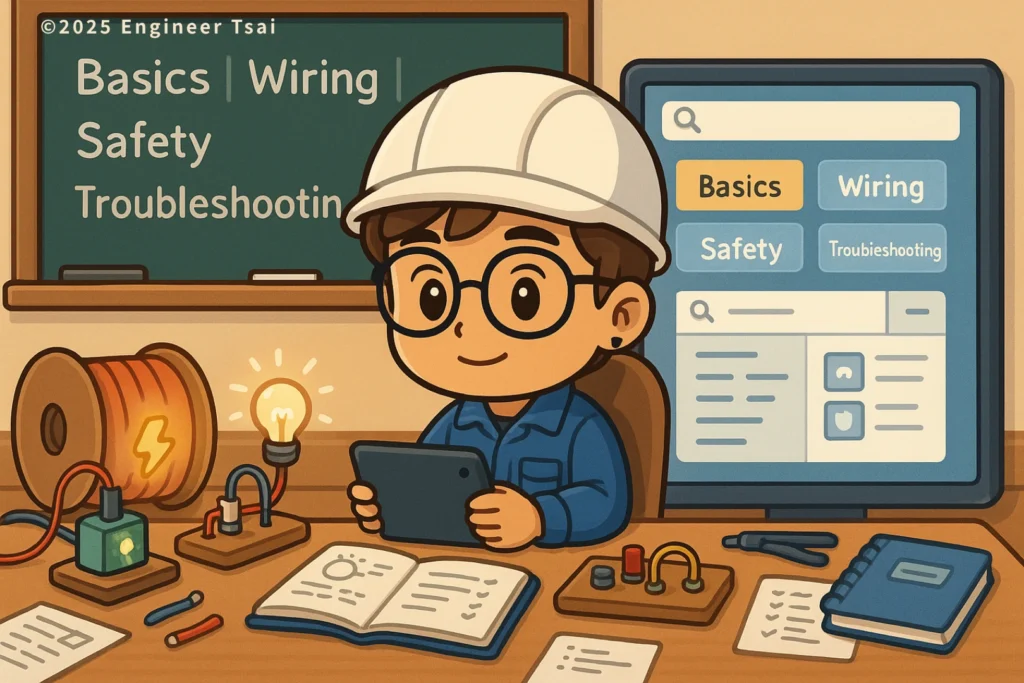Electrical Calculator Toolbox — one place for the everyday electrical math
Need the numbers before you pull wire or quote a job? This electrical calculators page gives you fast answers for voltage drop, wire size/AWG, single-phase & three-phase power, and kW↔kVA↔kVAR conversions. Because speed matters in the field, every tool is lightweight, clear, and tuned for typical NEC workflows.

Start here of electrical calculators
- Voltage Drop Calculator — single/three-phase, percent drop and suggested wire size. →
/voltage-drop-calculator - 1-Phase / 3-Phase Power Calculator — P-V-I-PF math with kW/kVA/kVAR. →
/single-three-phase-power-calculator - Wire Size Calculator (AWG ↔ mm²) — pick a run, current, and drop target. →
/wire-size-calculator - kW ↔ kVA ↔ kVAR Converter — quick power triangle math. →
/kw-kva-kvar-calculator - PF (Power Factor) Calculator — find PF from kW and kVA, or solve for current. →
/power-factor-calculator
Tip: If you work residential 120/240 V or commercial 277/480 V, these tools default to those values so you can move faster.
Why electricians use calculators instead of “head math”
On a long day it’s easy to miss a factor of 2L on single-phase, forget the √3 on three-phase, or mix up kW and kVA. Therefore, a reliable calculator prevents change orders, nuisance trips, and callbacks. In addition, it helps apprentices learn the pattern while keeping journeymen quick and consistent.
When should you use which electrical calculators?
- Sizing a branch circuit or feeder — start with Voltage Drop; if you’re near 3% at the branch or 5% total, bump the conductor.
- Figuring motor or EV charging load — use the 1ϕ/3ϕ Power Calculator with actual PF; as a result, your breaker and conductor choice matches real demand.
- Comparing copper vs aluminum — run the same current/length in the Wire Size Calculator; however, always check terminals and torque listings.
- Estimating generator/UPS size — convert with kW↔kVA↔kVAR and set a sensible PF.
Voltage drop: when is it critical?
- Long exterior runs: driveway lighting, detached garages, docks.
- Starting loads: well pumps, compressors, heat pumps, and EVSE—keep branch drop tighter than 3%.
- Low-voltage lighting & controls: even small absolute loss is a big percent at 12/24 V.
- Commercial three-phase: the geometry helps, nevertheless, check both feeder and branch because margins stack.
How this toolbox fits your learning path (skill tree)
Beginner → learn the P-V-I-PF triangle and try the 1ϕ/3ϕ power tool.
Intermediate → practice voltage drop and wire size decisions with a 3% / 5% target.
Advanced → layer on ampacity, derating, and OCPD coordination; then verify against your local code.
Extended reading about electrical calculators (internal links)
- Panel upgrades & breaker selection
- AFCI/GFCI protection basics →
/afci-gfci-guide - Copper vs Aluminum — wire size & ampacity →
/wire-size-ampacity
References (outbound links)
- NEC informational notes on voltage drop (3% / 5%)
- Engineering Toolbox — conductor resistivity tables
- NEMA/ANSI wire and AWG references
Disclaimer: These calculators are for education and pre-design checks. Therefore, final selections must follow the NEC and local amendments, equipment listings, and the AHJ or project engineer. When in doubt, upsize and document your assumption.
FAQ
Yes—formulas follow common industry practice; however, you still need to check ampacity, installation method, ambient temperature, grouping/derating, and breaker coordination.
Not for branch circuits, but feeders and services in light commercial often use three-phase. Consequently, it helps to understand both.
Aim for ≤3% on a branch and ≤5% total feeder + branch. In addition, sensitive loads may need tighter limits.
Absolutely. Meanwhile, you can toggle m ↔ ft and Cu ↔ Al; the calculators update instantly.
